Vegan Rose Basundi is a rich, creamy, and easy dairy-free twist on the classic Indian dessert. Infused with the delicate aroma of rose and flavored with fragrant spices and nuts, this indulgent treat is perfect for festive or special occasions. Make it in just 40 minutes and impress your guests with its luscious texture and floral sweetness! No one will believe this Sweet Basundi recipe vegan!
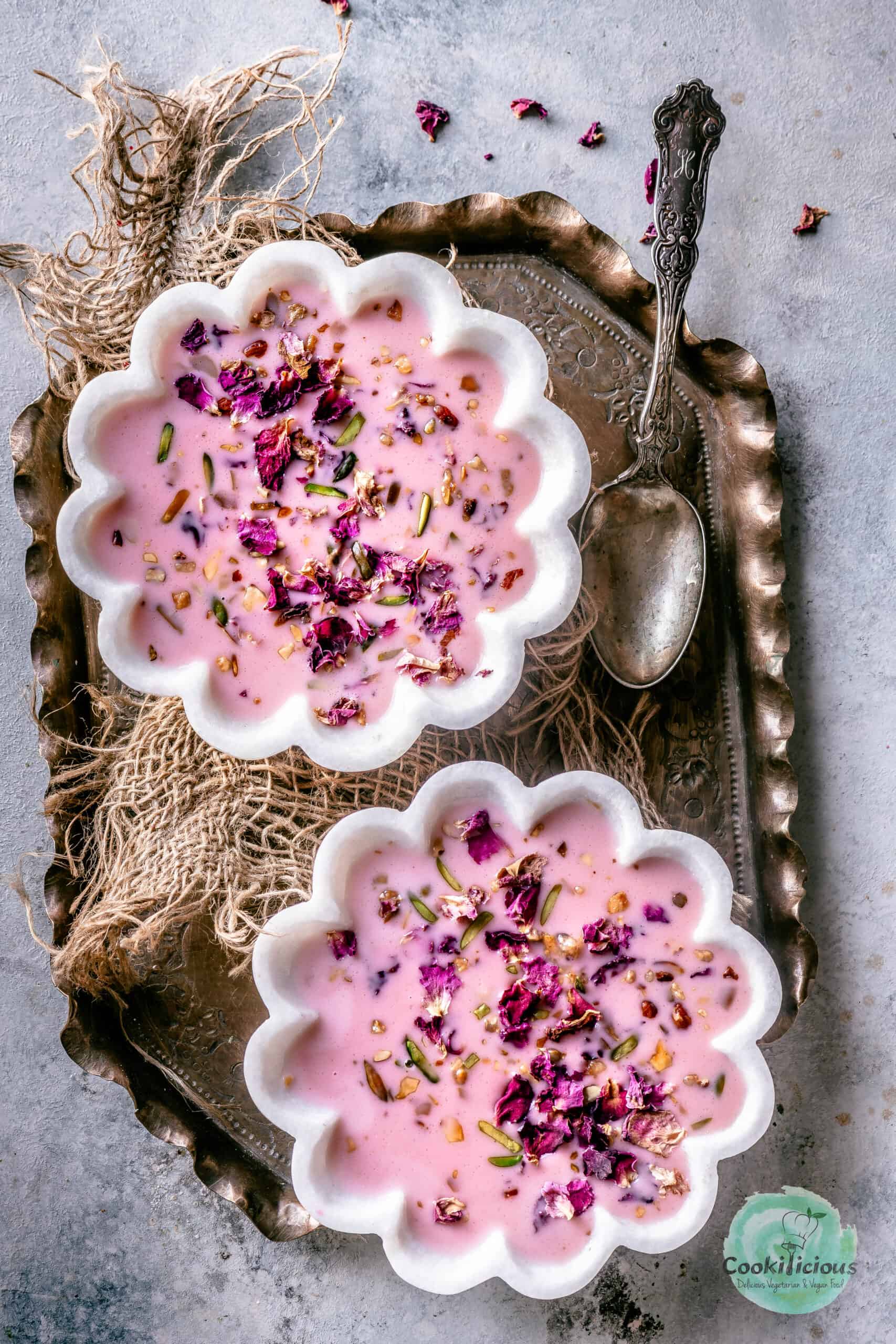
Jump to:
What is Basundi
Basundi, also known as Basundhi, is a traditional Indian milk dessert originating from Gujarat but is also popular in Maharashtra, Tamil Nadu, Andhra Pradesh, and Karnataka. This rich and creamy milk-based sweet dish is made by slow-cooking and reducing full-fat milk until it thickens. Homemade Basundhi is then flavored with sugar, cardamom, saffron, and nuts, giving it a deliciously indulgent taste. Gujarati Basundi is often compared to Rabdi (another milk dessert), but it has a slightly thinner consistency.
While the classic Basundi dessert recipe is slow-cooked on the stovetop, requiring continuous stirring for the perfect thickened milk texture, modern methods, including vegan Basundi alternatives, make the process quicker and easier. Unlike Kheer or Payasam, which include ingredients like rice, sabudana, or vermicelli, Sweet Basundi is purely milk-based, making it a smooth and creamy Indian dessert drink. Instant Basundi is commonly prepared during festivals, special occasions, at restaurants, and as prasadam.
Rose-Flavored Basundi
There are many Basundi variations, including the delightful Rose Basundi, which adds a fragrant floral twist to this traditional sweet. Rose-flavored desserts not only enhance the aroma but also make the sweet dish visually stunning. While store-bought Basundi mix is available, making it fresh at home ensures a more authentic taste.
My vegan Sweet Basundi recipe is dairy-free and comes together in less time while maintaining the same rich and creamy texture. This creamy Vegan Rose Basundi is made with coconut milk and flavored with rose syrup, making it a perfect festive treat!
Some rose-flavored desserts on my blog are Mohabbat Ka Sharbat, Mango Rose Lassi, Rose Lemonade, Rose Coconut Ladoos, Rose Sandesh, Gulkand Ice Cream, and Raspberry Rose Hot Chocolate.
Rabri Vs Basundi Vs Firni
While Rabri, Basundi, and Firni are all milk-based rich Indian desserts flavored with similar ingredients, their textures and methods of preparation is what sets these Indian milk puddings apart.
Rabri, originating from North India, is thick and creamy, made by simmering full-fat milk until it reduces significantly, forming layers of malai that give it a slightly grainy texture. It's flavored with saffron, cardamom, and nuts, often served with Malpua or Jalebi. I use homemade Rabdi to make Shahi Tukda. It's so good.
Basundi, popular in Maharashtra and Gujarat, is similar but thinner, as the milk is reduced less, resulting in a smoother and more fluid consistency. It is typically enjoyed on its own or with Puri.
Firni, a Mughlai dessert, is a rice pudding made by slow-cooking ground rice with milk, sugar, and aromatic spices like saffron and cardamom. It has a silky, pudding-like texture and is traditionally served chilled in earthen pots. I make Mango Phirni and it gives a nice variation to the sweet dish.
Plant-Based Twists On Classic Indian Sweets
Indian desserts and dairy have always been closely linked, making it hard to imagine mithai without condensed milk, milk, ghee, paneer, or khoya. Traditional and fusion sweets like Sweet Pongal, Carrot Halwa Ice Cream, and Matka Kulfi typically rely on dairy to enhance their rich flavors.
However, I wanted to recreate some classic Indian dessert recipes for my vegan audience. With a few simple swaps and tweaks, I discovered that making vegan Indian sweets is easier than it seems. Plant-based alternatives not only retain the authentic taste and texture but also offer a delicious, dairy-free twist on traditional favorites.
Aval Kesari, Coconut Ladoo, Sweetcorn Pudding, Carrot Halwa, Semiyan Payasam, Sweet Pongal, and Beetroot Halwa are some of my favorite vegan Indian dessert recipes. Teff Kheer Porridge, Sweet Potato Stuffed Puranpoli, Karanji Baklava, and Carrot Halwa Baklava are fusion Indian desserts that are also dairy-free. I use vegan honey, and dairy-free ghee when making plant-based desserts.
Why make this
- A plant-based twist on the classic Indian dessert
- Made without condensed milk or khoya
- Uses simple pantry staples-no fancy ingredients needed
- A crowd-pleaser loved by both kids and adults
- Perfect for festivals, celebrations, and gatherings
- This quick and easy vegan Basundi recipe is easily scalable-double or halve as needed
Ingredients needed 🧾
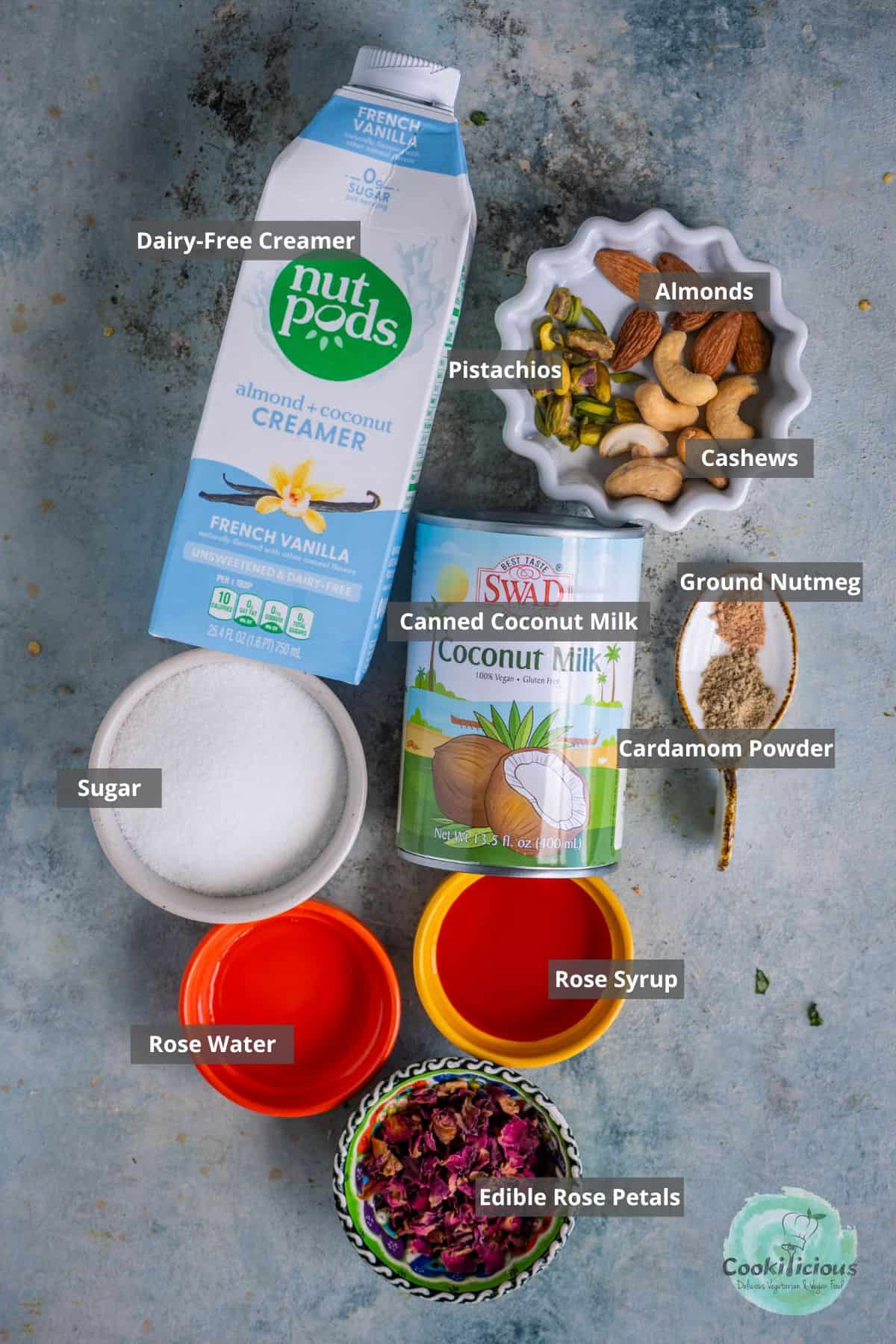
- Creamer - Use any dairy-free creamer; I've used an almond + coconut milk creamer for a rich texture. You can also opt for vegan evaporated milk or plant-based whipping cream.
- Milk - I've used a can of full-fat coconut milk for its creaminess, but you can also use sweetened or plain almond milk. I often use coconut milk in Tom Yum Soup, Coconut Ladoos, Chocolate Coconut Ice Cream, and Sweetcorn Pudding.
- Sugar - I prefer powdered or fine sugar, but you can use any variety that suits your taste.
- Rose Flavor - A mix of rose syrup, rose water, and edible rose petals gives this dessert its floral essence. If using rose syrup, you can skip food coloring, as it naturally enhances the color. The combination of rose water and syrup adds a delicate floral aroma, making this dessert truly indulgent.
- Nuts - I've used pistachios, cashews, and almonds for crunch and flavor.
Besides these ingredients, I highly recommend using a heavy-bottomed pan to prevent the milk from scorching while simmering when making Gujarati Basundi at home.
How to make it 🔪
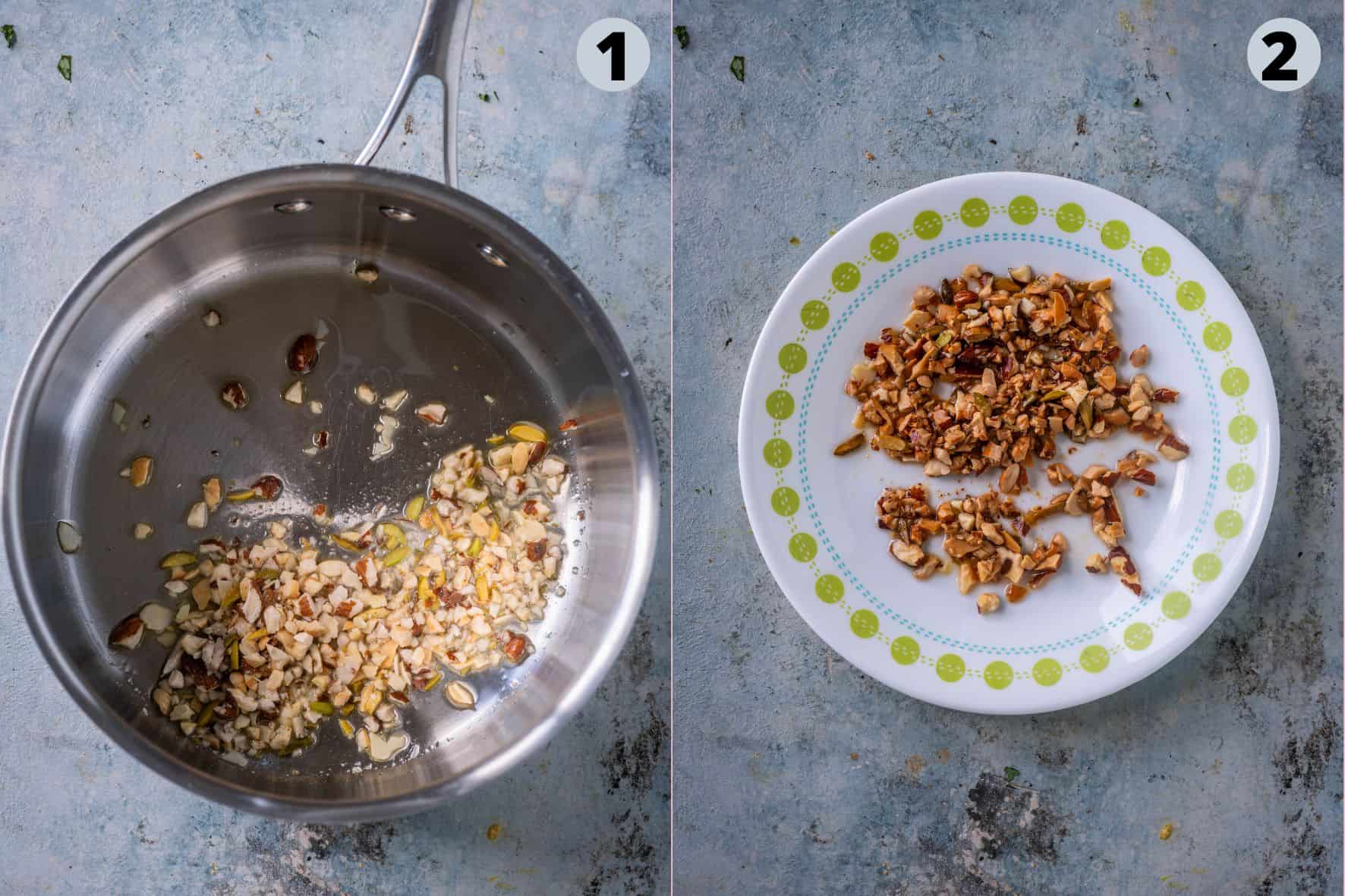
Want to save this recipe?
- Chop all the nuts using a nut chopper for uniform pieces. Heat vegan ghee in a wide-mouth, thick-bottomed pan and lightly fry the chopped cashews, pistachios, and almonds for 30 seconds until aromatic. Chef's Tip: A heavy-bottomed pan helps prevent the milk from scorching, ensuring a smooth and creamy texture.
- Once roasted, transfer the nuts to a plate and set them aside.
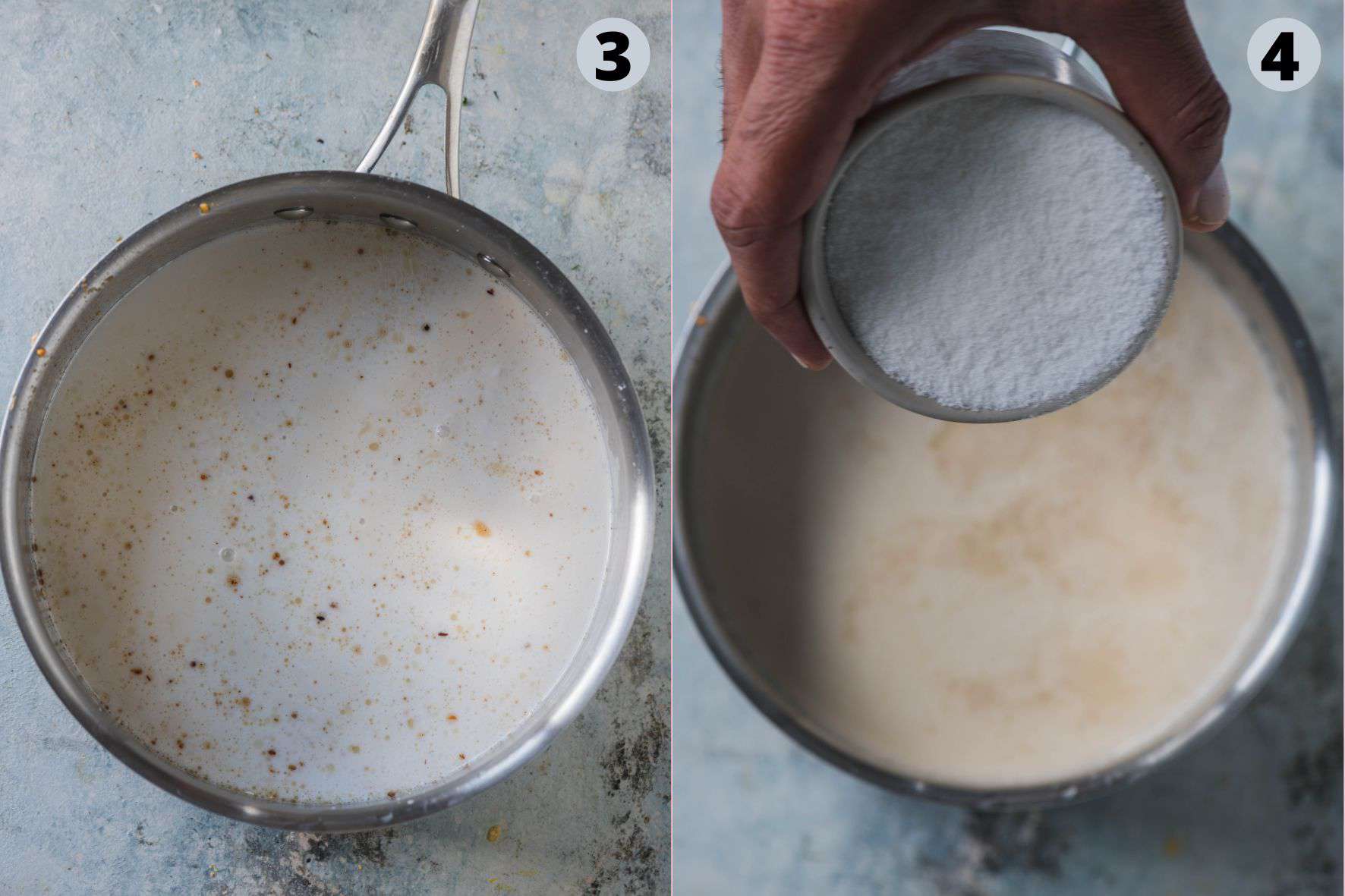
- Pour full-fat coconut milk and vegan creamer into the same pan-no need to clean it. Whisk well to ensure a smooth consistency without lumps. Bring the mixture to a gentle boil over low to medium heat, stirring regularly. This process will take about 15 minutes.
- As it simmers, scrape the sides of the pan and stir the thickened milk solids back in-this step enhances the creaminess of the Basundi. Once the mixture starts reducing, add sugar and continue cooking for another 5 minutes until it thickens slightly and develops a rich, creamy color. Keep stirring to prevent sticking and ensure even cooking.
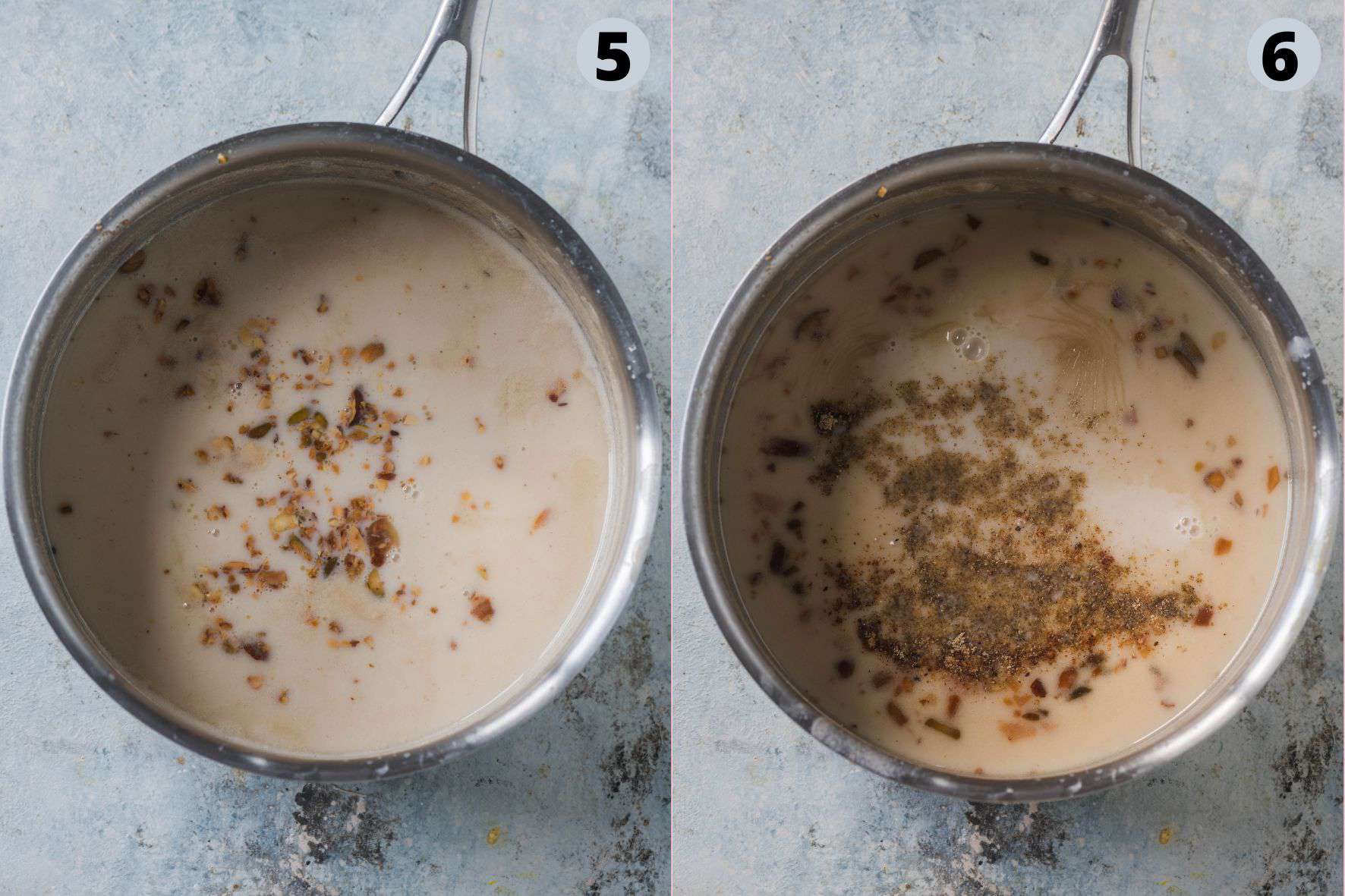
- Now, add the roasted nuts, reserving some for garnish. Continue cooking on low to medium heat for another 10 minutes, stirring occasionally to prevent sticking. Chef Tip: Do not cover the pan at any point, as this helps the mixture reduce properly.
- Once done, remove the Basundi from the heat and stir in rose water, rose syrup, cardamom powder, and ground nutmeg. Mix well-the color will gradually turn a beautiful pink. Cover the pan with a lid and let it cool to room temperature. The final consistency should be smooth and creamy, resembling a rich soup. Transfer to the refrigerator to chill before serving.
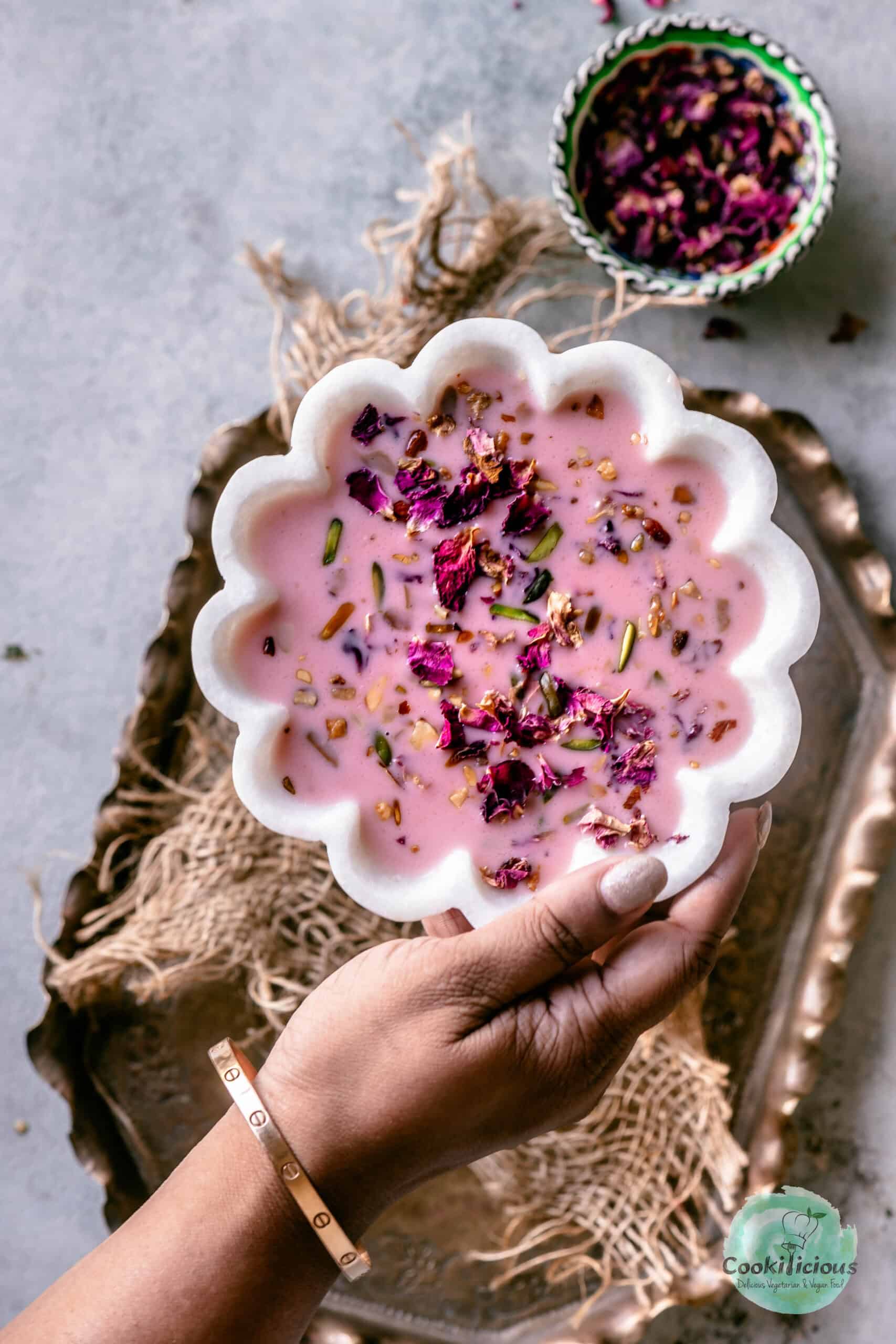
Serving suggestions 🍽
This vegan Basundi can be enjoyed hot or chilled, depending on your preference. Serve it as is in individual cups or bowls, or pair it with fried Puri for a classic combination-just like Aamras Puri or South Indian Paal Poli! For a creative twist, serve it in shot glasses as Basundi Shots, making it a fun and elegant festive Indian dessert drink.
This is the perfect quick dessert for sudden guests or special occasions like weddings, baby showers, pujas, parties, and potlucks. It's also ideal for festivals like Holi, Raksha Bandhan, Janmashtami, Ganesh Chaturthi, Diwali, Eid, Thanksgiving, Christmas, and Valentine's Day. Additionally, this dairy-free Indian dessert is great for Hindu fasting days (vrat) such as Nombu, Navratri, Shivratri, and Ekadashi.
Top recipe tips 💭
If you prefer a smooth texture, use nut powder instead of chopped or whole nuts, especially for kids or fussy eaters who don't like chunky bits. To enhance the authentic flavor, you can also add raisins, fresh chironji (chiroli), or dried fruits for extra richness. The cooking time depends on the type of vessel used and the heat level, so adjust accordingly to achieve the perfect creamy consistency.
Recipe FAQs 📖
For this Vegan Rose Basundi, I've used fine white sugar, which blends easily and maintains the dessert's light pink hue. Rose syrup also adds natural sweetness while enhancing the floral flavor. Vegan sweetened condensed milk is another great option-it not only sweetens but also helps thicken the coconut milk faster, reducing cooking time. If you prefer a more natural sweetener, jaggery or brown sugar can be used, but keep in mind that it will alter the color, making the Basundi darker instead of light pink.
You can prepare Basundi a day in advance, refrigerate it overnight, and serve it chilled the next day. It stays fresh in the fridge for 3-4 days but will thicken as it cools-just add some warm coconut milk to loosen the consistency before serving.
Basundi also freezes well for up to 3 months. Allow it to cool completely before transferring it to a freezer-safe container. When ready to serve, thaw overnight in the fridge and reheat in the microwave if needed.
Leftover Basundi can be creatively repurposed! Use it to make Basundi Ice Cream, similar to Carrot Halwa Ice Cream. Turn it into kheer by adding cooked rice or quick vermicelli. For a fusion twist, use it to soak cake layers for a Ras Malai Cake. You can even make overnight oats by soaking oats in leftover Basundi, similar to my Teff Kheer Porridge recipe.
Basundi dessert has many delicious flavor variations! Mango Basundi is made by adding mango pulp, similar to Mango Firni. For a refreshing twist, blend in paan paste and gulkand to create Paan Basundi. Thandai Basundi is infused with Thandai masala, making it perfect for festive occasions.
For a creamy twist, custard powder-often used in Fruit Custard-can be added for a unique texture. Fruit Basundi can be made by mixing in sitaphal (custard apple), figs (anjeer), apples, oranges, strawberries, or pineapple. If you prefer a classic version, you can make plain Basundi without any added flavors.
Other regional variations include Dudhi Basundi, made with bottle gourd, and Kesar Basundi, flavored with saffron. Angoor Basundi is a rich version where mini rasgullas are added, making it even more indulgent!
To achieve a rich and creamy texture, you can add paneer, khoya (mawa), milk powder, ricotta cheese, or custard powder. If you're making vegan Basundi, use almond powder or oats condensed milk as thickening agents. These ingredients enhance the thickened milk consistency while maintaining the authentic flavor of this delicious dessert.
If you're not vegan, you can make traditional Basundi using whole milk (full-fat) or evaporated milk. For a richer texture, mix in heavy cream, khoya (mawa), or milk powder while simmering. To naturally thicken the Basundi, replace sugar with regular condensed milk or Milkmaid. Finish it off with a touch of ghee for added richness and flavor.
Lightly grease the inner pot of the Instant Pot with ghee, covering the bottom and halfway up the sides to prevent the milk from sticking. Set the Instant Pot to Sauté mode and pour in 4 cans of evaporated milk, half can of sweetened condensed milk, half a teaspoon ofcardamom powder, and a few strands of saffron. Stir well and bring the mixture to a rolling boil, stirring constantly to prevent any milk from sticking.
Cooking Options:
Option A: Continue cooking on Sauté mode for 20-25 minutes, stirring occasionally until the Basundi reaches the desired consistency.
Option B: Switch to Slow Cook mode for 2 hours. After this time, check the thickness-if needed, continue on Slow Cook mode or switch to Sauté mode to finish reducing.
Once done, stir in chopped nuts and serve warm or chilled. Enjoy this rich and creamy dessert!
More Dessert Recipes
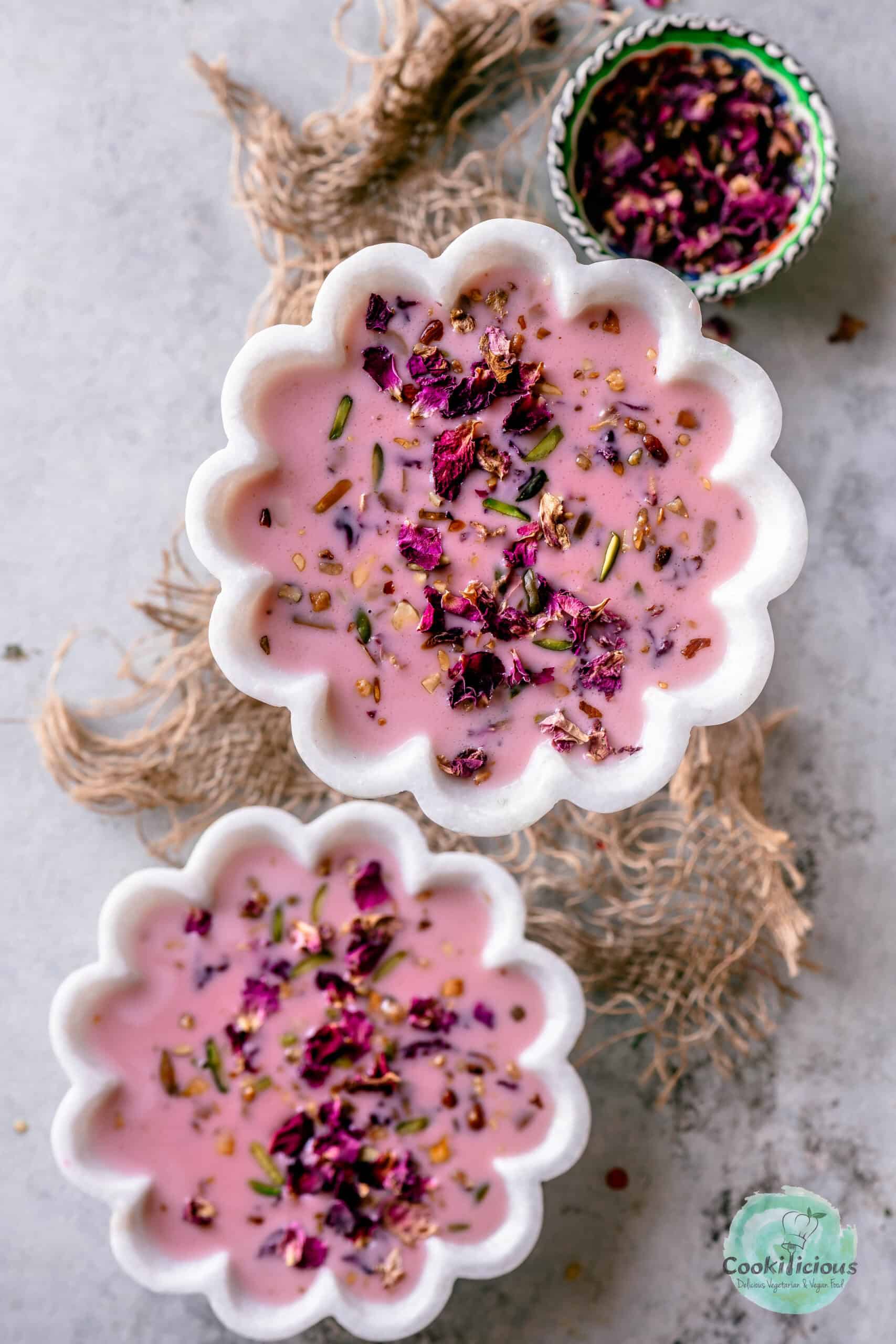
⭐️ Subscribe to the Cookilicious Newsletter and receive new recipes straight to your inbox! You'll receive my FREE Vegan Beginner's guide as a gift. Ready to elevate your cooking game? Purchase my Cookbook - The Essential Vegan Indian Cookbook today!
Recipe 📖
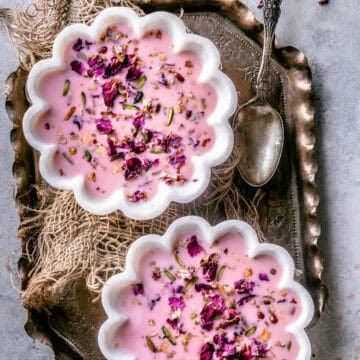
Delicious Rose Basundi Recipe
Equipment
Ingredients
- 1 teaspoon vegan ghee
- 2 tablespoon cashews
- 2 tablespoon almonds
- 2 tablespoon silvered pistachios
- 13.5 fl.oz canned coconut milk
- 2 cups vegan creamer
- 1 teaspoon saffron
- ½ cup sugar
- 2 tablespoon rose syrup
- ½ tablespoon rose water
- ¼ teaspoon cardamom powder
- ⅛ teaspoon ground nutmeg
- 1 tablespoon edible rose petals
Instructions
- Chop all the nuts using a Nut Chopper. Heat vegan ghee in a small pan and fry chopped cashews, pistachios, and almonds for 30 seconds.
- Transfer the roasted nuts to a plate.
- Pour full-fat coconut milk and vegan creamer in the same pan. Whisk it to ensure there are no lumps in the coconut milk. Bring to a boil. Keep the flame on low to medium. This could take 15 minutes.
- Keep stirring at regular intervals and scraping the sides of the pan to avoid scorching. Then add sugar. Continue to cook for another 5 minutes. The mixture should reduce and thicken a bit. The color of the Basundi will also change and become creamy.
- Now add the roasted nuts. Reserve some for garnish. Continue to cook it for another 10 minutes on low to medium flame. Keep stirring at intervals.
- Take the Basundi off the flame. Add rose water, cardamom powder and ground nutmeg. Mix.
- You can serve this vegan Basundi immediately or later when its chilled. Garnish with rose petals and rose syrup before serving.

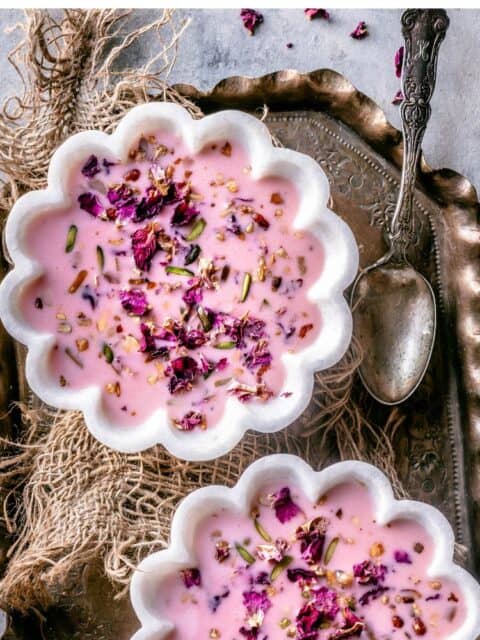
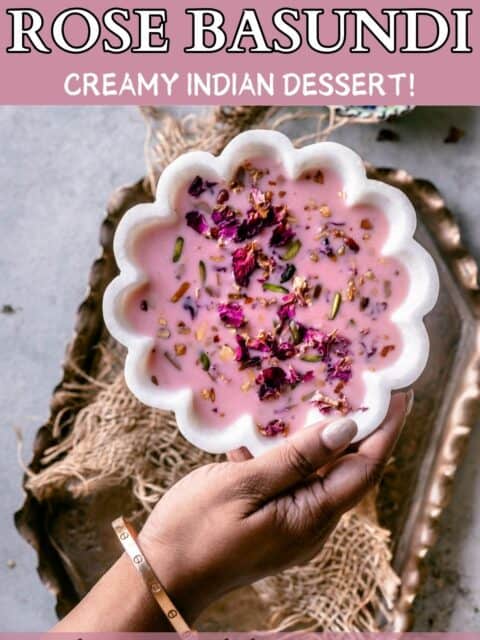
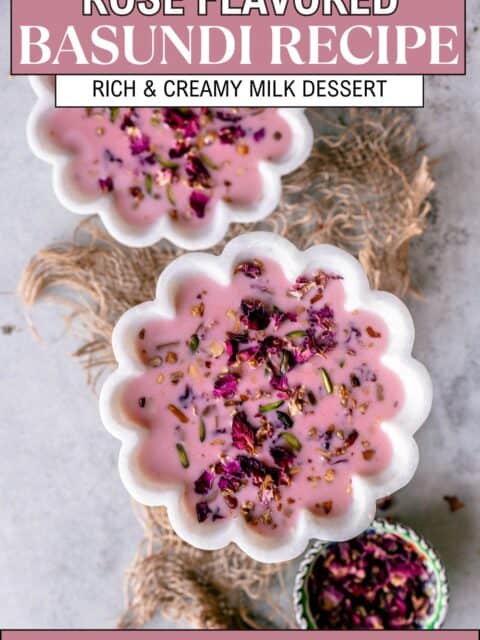
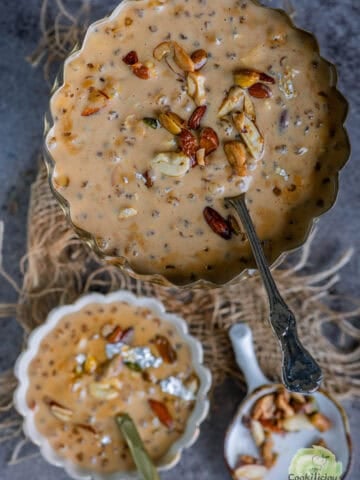
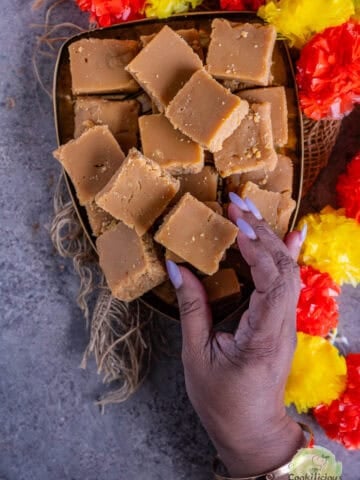
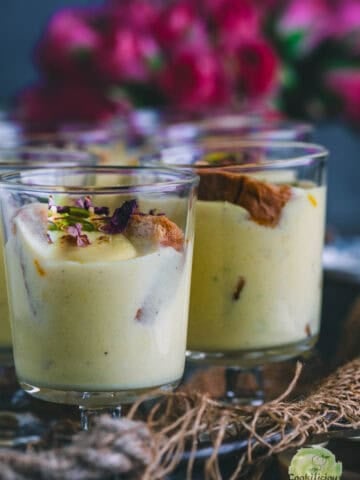
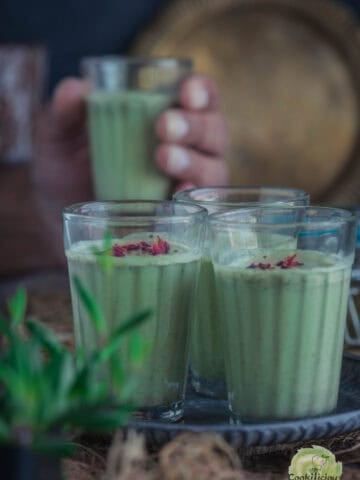

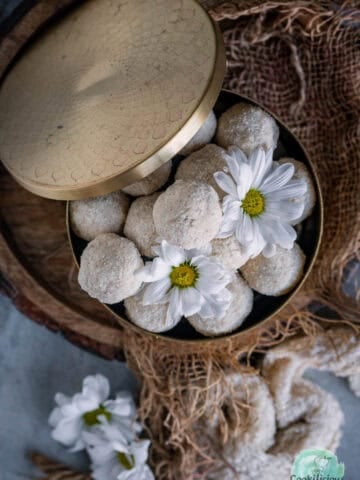
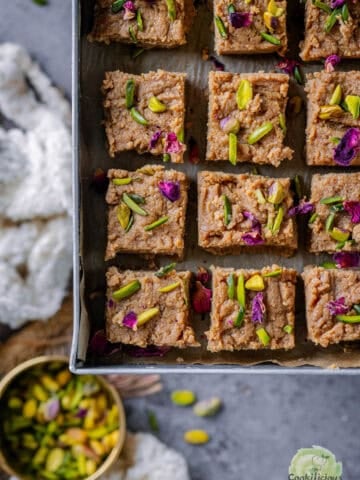
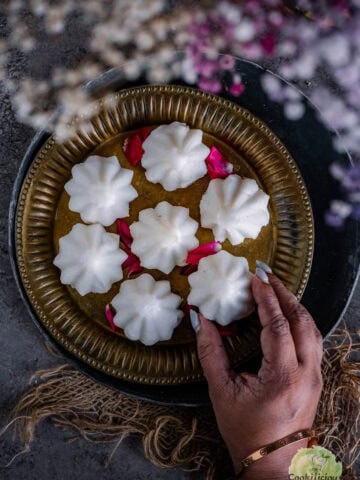
fat tiger ready-to-eat momos says
This basundi recipe is a must-try
Priya says
Thank you.